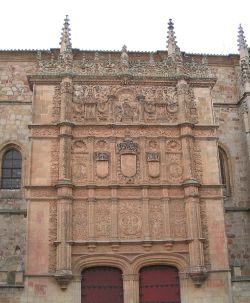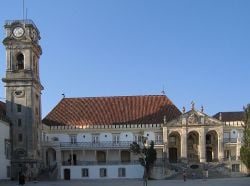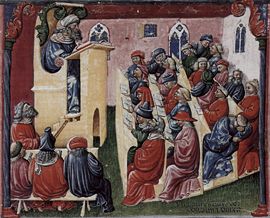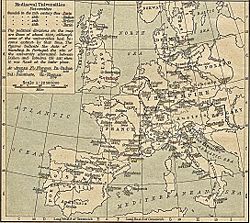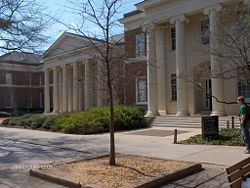Difference between revisions of "University" - New World Encyclopedia
Rosie Tanabe (talk | contribs) |
|||
| (30 intermediate revisions by 7 users not shown) | |||
| Line 1: | Line 1: | ||
| − | {{ | + | {{Images OK}}{{Submitted}}{{Approved}}{{Paid}}{{Copyedited}} |
[[Category:Politics and social sciences]] | [[Category:Politics and social sciences]] | ||
[[Category:Education]] | [[Category:Education]] | ||
| − | '' | + | {{Schools}} |
| − | [[Image: | + | A '''university''' is an institution of [[higher education]] and [[research]], which grants [[academic degree]]s at all levels ([[bachelor degree|bachelor]], [[master degree|master]], and [[doctorate degree|doctorate]]) in a variety of subjects. A university provides both [[tertiary education|tertiary]] and [[Postgraduate education|quaternary education]]. The word ''university'' is derived from the [[Latin]] ''universitas magistrorum et scholarium'', roughly meaning "community of [[teacher]]s and [[scholar]]s." |
| + | {{toc}} | ||
| + | Universities are seen as a place of great personal development, but have the reputation of isolation or independence from regular society due to the often erudite nature of subjects studied therein. Regardless of their exact nature, universities fall within the purview of education, in particular higher education after the level considered necessary to function effectively as an adult citizen—that offered by [[elementary school|elementary]] and [[high school]]s. As such, colleges teach more specialized mastery of particular skills, greater depth in academic knowledge, or otherwise advance the individual interests and talents of their students. This aspect of education is built on, and requires, the foundation of earlier education, which includes not only academic knowledge but the emotional development and social skills that are acquired in earlier childhood. | ||
| + | |||
| + | ==Overview== | ||
| + | [[Image:Moskau Uni.jpg|thumb|left|250 px|[[Moscow State University]] at [[Sparrow Hills]] is the largest educational building in the world.]] | ||
| + | |||
| + | The word university means "institution of higher learning" or "body of persons constituting a university." The word comes from the [[Latin]] ''universitatum'', meaning corporation or society.<ref>[http://www.etymonline.com/index.php?search=university&searchmode=none University] ''Online Etymology Dictionary''. Retrieved March 27, 2020.</ref> | ||
| − | + | University is one type of [[tertiary education]]. Other forms include [[vocational school]]s and [[community college]]s. Vocational schools are more narrow in their focus and often have some immediate professional goal in mind such as a training for a career as a paralegal or auto-mechanic. Community colleges offer continuing adult education for those interested in taking classes for personal enjoyment or interest. They also serve as preparatory schools for four year university undergraduate programs or as alternatives to those who cannot afford to enroll in a traditional four year program. In the United States, university is used to refer to schools offering graduate education while [[college]]s offer undergraduate education. | |
| − | |||
==History== | ==History== | ||
| − | + | [[Image:Oxfordceremony.jpg|thumb|right|250 px|[[Degree ceremony]] at the [[University of Oxford]]. The Pro-Vice-Chancellor in [[Master of Arts (Oxbridge and Dublin)|MA]] gown and hood, [[Proctor]] in official dress and new [[Doctor of Philosophy|Doctors of Philosophy]] in scarlet full dress. Behind them, a [[bedel]], another Doctor and Bachelors of Arts and Medicine.]] | |
| − | [[Image:Oxfordceremony.jpg | + | The first universities were not actually degree-granting institutions. The original Latin word ''universitas'', first used in time of renewed interest in Classical [[Greece|Greek]] and [[Ancient Rome|Roman]] tradition, tried to reflect this feature of the [[Academy#The original Academy|Academy of Plato]]. The choice for the oldest institution of higher learning is usually among [[Nalanda]], [[University of Constantinople|Constantinople]], [[University of Al Karaouine|Al Karaouine]] or [[Al-Azhar University|Al-Azhar]]. Nalanda University, founded in [[Bihar]], [[India]] around the fifth century B.C.E. conferred academic degree titles to its graduates, while also offering [[postgraduate|post-graduate]] courses. Another Indian university whose ruins were only recently excavated was Ratnagiri University in [[Orissa]]. Chinese institutions of higher learning were the semi-legendary [[Shang Hsiang]], and later [[Taixue]] and [[Guozijian]] serve as the highest level of educational establishment while [[Academies (Shuyuan)|academies]] became very popular as non-governmental establishments teaching [[Confucianism]] and [[Chinese literature]] among other things. Also the [[acdemy of Gundishapour]] is one of the oldest universities in the world, made around the fourth century C.E. in [[Iran]]. |
| + | |||
| + | Al-Azhar University, founded in [[Cairo]], [[Egypt]] in the tenth century, offered a variety of post-graduate degrees, and is often regarded as the first full-fledged university. The [[University of Constantinople]], founded in 849, by the regent Bardas of emperor Michael III, is generally considered the first institution of higher learning with the characteristics we associate today with a university (research and teaching, auto-administration, academic independence, et cetera). The [[Guinness World Records|Guinness Book of World Records]] recognizes the [[University of Al Karaouine]] in [[Fez, Morocco]] as the oldest university in the world with its founding in 859. | ||
| + | |||
| + | ===Byzantine university=== | ||
| + | '''Byzantine university''' refers to higher education during the era of the [[Byzantine empire]]. | ||
| + | |||
| + | The medieval [[Greeks|Greek]] world had no autonomous and continuing institutions of higher learning comparable to the [[Medieval university|universities of the later Middle Ages in Western Europe]], but higher education was provided by private teachers, professional groups and state appointed teachers. | ||
| + | |||
| + | In the early period [[Rome]], [[Athens]], and [[Alexandria]] were the main centers of learning, but were overtaken in the fifth century by the Queen of cities, [[Constantinople]]. After the closing of the [[Academy in Athens]] in 529 due to its pagan teachings, and the [[Arab conquests|conquest of Alexandria and Beirut by the Arabs]] in the mid seventh century, the focus of all higher learning moved to Constantinople. | ||
| + | |||
| + | After the foundation of Constantinople in 330 teachers were drawn to the new city and various steps were taken for official state support and supervision, however nothing lastingly formal in the way of state funded education emerged. However in 425 [[Theodosius II]] established a clear distinction between teachers who were private, and those who were public and paid from imperial funds. These official teachers enjoyed privilege and prestige. There were a total of 31 teachers: ten each for [[Greek language|Greek]] and [[Latin]] grammar; five for Greek [[rhetoric]]; three for Latin rhetoric; two for law; one for philosophy. This system lasted with various degrees of official support until the seventh century. | ||
| + | [[Image:University of Salamanca.jpg|thumb|250px|University of Salamanca (Spain) founded in 1218]] | ||
| + | In the seventh and eighth centuries Byzantine life went through a difficult period (sometimes called the [[Byzantine Dark Age]]). Continued Arab pressure from the south and the [[Slavs]], [[Eurasian Avars|Avars]] and [[Bulgars]] to the north led to dramatic economic decline and transformation of Byzantine life. However during this period higher education continued to receive some official funding, the details of which are not well known to scholars, but it is assumed the quality of the education was probably low. | ||
| + | |||
| + | With improving stability in the ninth century came measures to improve the quality of higher education. In 863 chairs of grammar, rhetoric and philosophy (includes [[mathematics]], [[astronomy]], and [[music]]) were founded and given a permanent location in the imperial palace. These chairs continued to receive official state support for the next century-and-a-half, after which the leading role in the provision of higher education was taken up the Church. During the twelfth century the [[Patriarchal School]] was the leading center of education which included men of letters such as [[Theodore Prodromos]] and [[Eustathius of Thessalonica]]. | ||
| + | [[Image:Coimbra University Tower 2.jpg|thumb|left|250 px|The tower of the [[University of Coimbra]], the oldest Portuguese university.]] | ||
| + | The capture of Constantinople in 1204 by [[Crusade|Crusaders]] during the [[Fourth Crusade]] ended all support for higher education, although the government in exile in [[İznik|Nicaea]] gave some support to individual private teachers. After the restoration in 1261 attempts were made to restore the old system, but it never fully recovered and most teaching fell to private teachers and professions. Some of these private teachers include the diplomat and monk [[Maximos Planudes]] (1260-1310), the historian [[Nikephoros Gregoras]] (1291-1360), and the man of letters [[Manuel Chrysoloras]], who taught in [[Florence]] and influence the early Italian humanists on Greek studies. In the fifteenth century many more teachers from Constantinople would follow in Chrysoloras' footsteps. | ||
| + | |||
| + | ===Medieval European universities=== | ||
| + | The first [[Europe|European]] medieval institutions generally considered to be universities were established in [[Italy]], [[France]], and [[England]] in the late eleventh and the twelfth centuries for the study of [[Liberal arts|arts]], [[law]], [[medicine]], and [[theology]]. These universities evolved from much older schools and [[monastery|monasteries]], and it is difficult to define the date at which they became true universities, although the lists of [[studium generale|studia generalia]] for higher education in Europe held by the [[Roman Curia|Vatican]] are a useful guide. A different case is the university of [[Constantinople]], which was founded in the ninth century as a secular institute of higher learning, to support the state administration. | ||
| + | |||
| + | [[Image:Laurentius de Voltolina 001.jpg|270px|right|thumb|Representation of a university class, (1350s).]] | ||
| + | With the increasing professionalization of society during the twelfth and thirteenth centuries, a similar demand grew for professional [[clergy]]. Before the twelfth century, the intellectual life of Europe had been relegated to monasteries, which were mostly concerned with the study of the [[liturgy]] and [[prayer]]; very few monasteries could boast true intellectuals. Following the [[Gregorian Reform]]'s emphasis on canon law and the study of the [[sacrament]]s, bishops formed [[cathedral school]]s to train the clergy in [[Canon law (Catholic Church)|Canon law]], but also in the more secular aspects of church administration, including logic and disputation for use in preaching and theological discussion, and accounting to more effectively control finances. | ||
| − | + | Learning became essential to advancing in the ecclesiastical hierarchy, and teachers also gained prestige. However, demand quickly outstripped the capacity of cathedral schools, each of which was essentially run by one teacher. In addition, tensions rose between the students of cathedral schools and burghers in smaller towns. So, cathedral schools migrated to large cities, like [[Paris]] and [[Bologna]]. | |
| − | + | The predecessor of the modern university found its roots in [[Paris]], especially under the guidance of [[Peter Abelard]], who wrote ''[[Sic et Non]]'' ("Yes and No"), which collected texts for university study. Dissatisfied with tensions between burghers and students and the censorship of leading intellectuals by the Church, Abelard and others formed the ''Universitas'', modeled on the medieval [[guild]], a large-scale, self-regulating, permanent institution of higher education. | |
| − | |||
| − | + | By the thirteenth century, almost half of the highest offices in the Church were occupied by degreed masters ([[abbot]]s, [[archbishop]]s, [[cardinal (Catholicism)|cardinals]]), and over one-third of the second-highest offices were occupied by masters. In addition, some of the greatest theologians of the [[High Middle Ages]], [[Thomas Aquinas]] and [[Robert Grosseteste]], were products of the medieval university. | |
| − | The | + | The development of the medieval university coincided with the widespread reintroduction of [[Aristotle]] from [[Byzantine Empire|Byzantine]] and [[Arab]] scholars and the decline in popularity of [[Platonism]] and [[Neoplatonism]] in favor of Aristotelian thought. |
| − | + | [[Image:medieval-university.jpg|thumb|left|250px|Class in a medieval university, [[illuminated manuscript]] from the thirteenth century.]] | |
| + | Initially medieval universities did not have a [[campus]]. Classes were taught wherever space was available such as churches and homes, a university was not a physical space but a collection of individuals banded together as a ''universitas'' (the corporation). Soon, however, some universities (such as [[University of Cambridge|Cambridge]]) began to buy or rent rooms specifically for the purposes of teaching. | ||
| − | + | Universities were generally structured along three types, depending on who paid the teachers. The first type was in [[University of Bologna|Bologna]], where students hired and paid for the teachers. The second type was in [[University of Paris|Paris]], where teachers were paid by the church. Oxford and Cambridge were predominantly supported by the crown and the state, a fact which helped them survive the [[Dissolution of the Monasteries]] in 1538 and the subsequent removal of all the principal [[Catholic]] institutions in [[England]]. These structural differences created other characteristics. At the Bologna university the students ran everything—a fact that often put teachers under great pressure and disadvantage. In Paris, teachers ran the school; thus Paris became the premiere spot for teachers from all over Europe. Also, in Paris the main subject matter was theology, so control of the qualifications awarded was in the hands of an external authority—the Chancellor of the diocese. In Bologna, where students chose more secular studies, the main subject was law. | |
| − | + | University studies took six years for a [[Bachelor's degree]] and up to 12 additional years for a master's degree and doctorate. The first six years were organized by the [[faculty of arts]], where the seven [[liberal arts]] were taught: [[arithmetic]], [[geometry]], [[astronomy]], [[music theory]], [[grammar]], [[logic]], and [[rhetori]]c. The primary emphasis was on logic. | |
| − | + | Once a [[Bachelor of Arts]] degree had been conferred, the student could leave the university or pursue further studies, in one of the three other faculties—[[law]], [[medicine]], or [[theology]]—in which to pursue the [[master's degree]] and [[doctorate degree]]. Theology was the most prestigious area of study, and the most difficult. | |
| − | + | Courses were offered according to books, not by subject or theme. For example a course might be on a book by [[Aristotle]], or a book from the [[Bible]]. Courses were not elective: the course offerings were set, and everyone had to take the same courses. There were, however, occasional choices as to which teacher to use. | |
| + | [[Image:Map_of_Medieval_Universities.JPG|right|thumb|250px|left|''Map of Mediaeval Universities'']] | ||
| + | Students entered the University at 14 to 15 years of age. Classes usually started at 5:00 a.m. or 6:00 a.m.. Students were afforded the legal protection of the clergy. In this way no one was allowed to physically harm them; they could only be tried for crimes in a church court, and were thus immune from any [[corporal punishment]]. This gave students free rein in urban environments to break secular laws with impunity, a fact which produced many abuses: [[theft]], [[rape]], and [[murder]] were not uncommon among students who did not face serious consequences. This led to uneasy tensions with secular authorities. Students would sometimes "strike" by leaving a city and not returning for years. This happened at the [[University of Paris strike of 1229]] after a [[riot]] (started by the students) left a number of students dead; the University went on strike and they did not return for two years. As the students had the legal status of clerics which, according to the Canon Law, could not be held by women, women were not admitted into universities. | ||
| − | + | A popular textbook for university study was called the ''Sentences'' ''(Quattuor libri sententiarum)'' of [[Peter Lombard]]; theology students and masters were required to write extensive commentaries on this text as part of their curriculum. Much of medieval thought in philosophy and theology can be found in [[scholastic]] textual commentary because scholasticism was such a popular method of teaching. | |
| − | + | Most universities of international excellence in Europe were registered by the [[Holy Roman Empire]] as a [[Studium generale|Studium Generale]]. Members of these institutions were encouraged to disseminate their knowledge across Europe, often giving lecture courses at a different Studium Generale. | |
| − | |||
| − | + | ===Medieval Asian universities=== | |
| + | Outside of Europe, there were many notable institutions of learning throughout history. In [[China]], there was the famous [[Hanlin Academy]], established during the [[Tang Dynasty]] (618-907 C.E.), and was once headed by the Chancellor [[Shen Kuo]] (1031-1095), a famous Chinese scientist, inventor, mathematician, and statesman. | ||
| − | + | Medieval universities did not exist in Asia in the strict sense of the phrase. However, there were important centers of learning that can be compared to the universities of Europe. It must be noted that unlike the European universities, non-western institutions of higher learning were never known to issue degrees to their graduates and therefore do not meet what many hold to be the technical definition of [[university]]. This does not, however, bar their importance to the history of non-western cultures. | |
| − | |||
| − | + | One of the most important Asian centers of learning was [[Nalanda]], which had been established by the fifth century B.C.E., in [[Bihar (India)|Bihar]], [[India]]. The second century Buddhist philosopher [[Nagarjuna]] was based there. | |
| − | + | [[Nanjing University]] was founded in 258 in [[China]]. There were several other universities, called [[Guozijian]], in ancient China. | |
| − | + | In [[Iran|Persia]], one notable institution was the [[Academy of Gundishapur]]. | |
| − | + | In the [[Near East]], such as the Islamic [[Al-Azhar University]] in [[Cairo]], founded in 988. | |
| − | [[ | ||
| − | + | In [[Vietnam]], the [[Văn Miếu|Quoc Tu Giam]] (國子監, literally "National University"), functioned for more than 700 years, from 1076 to 1779. | |
| − | + | ===Emergence of modern universities=== | |
| + | [[Image:universityofbath indoor tennis courts arp.jpg|thumb|250 px|right|Indoor [[tennis court]]s are part of extensive sports facilities at the [[University of Bath]], [[England]].]] | ||
| + | The end of the medieval period marked the beginning of the transformation of universities that would eventually result in the modern research university. Many external influences, such as eras of [[Renaissance humanism|humanism]], [[Age of Enlightenment|Enlightenment]], [[Protestant Reformation|Reformation]], and revolution, shaped research universities during their development, and the discovery of the [[New World]] in 1492 added [[human rights]] and [[international law]] to the university [[curriculum]]. | ||
| − | + | By the eighteenth century, universities published their own [[academic journal|research journals]], and by the nineteenth century, the [[Germany|German]] and the [[France|French]] university models had arisen. The German, or Humboldtian model, was conceived by [[Wilhelm von Humboldt]] and based on [[Friedrich Schleiermacher]]’s liberal ideas pertaining to the importance of [[Freedom (philosophy)|freedom]], [[seminar]]s, and [[laboratory|laboratories]] in universities. The French university model involved strict discipline and control over every aspect of the university. | |
| − | [[ | ||
| − | |||
| − | |||
| − | + | Universities concentrated on science in the nineteenth and twentieth centuries, and they started to become accessible to the masses after 1914. Until the nineteenth century, [[religion]] played a significant role in university curriculum; however, the role of religion in research universities decreased in the nineteenth century, and by the end of the nineteenth century, the German university model had spread around the world. The British also established universities worldwide, and [[higher education]] became available to the masses not only in Europe. In a general sense, the basic structure and aims of universities have remained constant over the years. | |
| − | |||
| − | + | ====Nazi universities==== | |
| − | + | Universities changed drastically in [[Nazi]] Germany. Books from university libraries, written by anti-Nazi or [[Jew]]ish authors, were burned in places (in Berlin for example) in 1933, and the curricula were subsequently modified. Jewish professors and students were expelled according to the [[racial policy of Nazi Germany]]. [[University of Poznań]] was closed by the Nazi Occupation in 1939, its faculty replaced with German substitutes. [[University of Strasbourg]] was transferred to [[Clermont-Ferrand]] and Reichsuniversität Straßburg existed 1941–1944. Nazi-run universities ended with the fall of Nazi Germany in 1945. | |
| − | |||
| − | |||
| − | |||
| − | |||
| − | |||
| − | |||
| − | |||
| − | |||
| − | |||
| − | |||
| − | |||
| − | |||
| − | |||
| − | |||
| − | |||
| − | |||
| − | |||
| − | |||
| − | |||
| − | |||
| − | |||
| − | |||
| − | |||
| − | |||
| − | |||
| − | |||
| − | |||
| − | |||
| − | |||
| − | |||
| − | |||
| − | |||
| − | |||
| − | |||
| − | |||
| − | |||
| − | |||
| − | |||
| − | |||
| − | |||
| − | |||
| − | |||
| − | |||
| − | |||
| − | |||
| − | |||
| − | |||
| − | |||
| − | |||
| − | |||
| − | |||
| − | |||
| − | |||
| − | |||
| − | == | + | ====Soviet universities==== |
| − | + | Soviet type universities existed in the [[Soviet Union]] and in other countries of the [[Eastern Bloc]]. | |
| + | Medical, technical, economical, technological and arts faculties were frequently separated from universities. Soviet ideology was taught divided into three disciplines: [[Scientific Communism]], [[Marxism-Leninism]], and [[Communism|Communist]] [[Political Economy]]) and was introduced as part of many courses, such as teaching [[Karl Marx]]' or [[Vladimir Lenin]]'s views on energy or history. [[Science]]s were generally tolerated, but [[humanities]] curbed. In 1922, the Bolshevik government expelled some 160 prominent intellectuals on the [[Philosophers' ship]], later some professors and students were killed or worked in [[Gulag]] camps. Communist economy was preferred, liberal ideas criticized or ignored. [[Genetics]] was reduced to [[Lysenkoism]] from the middle of the 1930s to the middle of the 1960s. Communist parties controlled or influenced universities. The leading university was the [[Moscow State University]]. After [[Joseph Stalin]]'s death, universities in some Communist countries obtained more freedom. The [[Peoples' Friendship University of Russia|Patrice Lumumba Peoples' Friendship University]] provided higher education as well as a [[KGB]] training ground for young communists from [[developing countries]]. The system failed during the years 1989-1991. In some countries a number of communists and political police informers were expelled from universities, political universities resolved or reorganized. | ||
| − | == | + | ==Organization== |
| − | + | [[Image:Brooks Hall UGA.jpg|right|250 px|thumbnail|Brooks Hall, home of the Terry College of Business at the [[University of Georgia]] in [[Athens, Georgia|Athens]], [[Georgia (U.S. State)|Georgia, United States]]]] | |
| − | + | Although each institution is differently organized, nearly all modern universities have a board of trustees, a president, [[chancellor (education)|chancellor]] or [[rector]], at least one vice president, vice-chancellor or vice-rector, and deans of various divisions. Universities are generally divided into a number of academic departments, schools or [[faculty (university)|faculties]]. [[Public university]] systems are ruled over by government-run higher education boards. They review financial requests and budget proposals and then allocate funds for each university in the system. They also approve new programs of instruction and cancel or make changes in existing programs. In addition, they plan for the further coordinated growth and development of the various institutions of higher education in the state or country. However, many public universities in the world have a considerable degree of financial, research and pedagogical autonomy. [[private university|Private universities]] are privately funded having generally a broader independence from state policies. | |
| − | [[ | + | Despite the variable policies, or cultural and economic standards available in different geographical locations create a tremendous disparity between universities around the world and even inside a country, the universities are usually among the foremost research and advanced training providers in every society. Most universities not only offer courses in subjects ranging from the [[natural sciences]], [[engineering]], [[architecture]] or [[medicine]], to [[sports science]]s, [[social science]]s, [[law]] or [[humanities]], they also offer many amenities to their student population including a variety of places to eat, banks, bookshops, print shops, job centers, and bars. In addition, universities have a range of facilities like [[library|libraries]], sports centers, [[students' union]]s, [[computer lab]]s, and [[laboratory|research laboratories]]. In a number of countries, major classic universities usually have their own [[botanical garden]]s, [[astronomical observatories]], [[business incubators]], and [[university hospital]]s. |
| + | ==Criticism== | ||
| + | In his study of the American university since [[World War II]], ''The Knowledge Factory'', [[Stanley Aronowitz]] argued that the American university has been besieged by growing [[unemployment]] issues, the pressures of big business on the land grant university, as well as the political passivity and "ivory tower" naivete of American academics. A part of these pressures results in debates over [[academic freedom]] in which professors, students, and administrators are coerced into working on or prevented from working on certain topics that may be controversial. | ||
| + | In a somewhat more theoretical vein, the late [[Bill Readings]] contended in his 1995 study ''The University in Ruins'' that the university around the world has been hopelessly commodified by [[globalization]] and the bureaucratic non-value of "excellence." His view is that the university will continue to linger on as an increasingly consumerist, ruined institution until or unless we are able to conceive of advanced education in transnational ways that can move beyond both the national subject and the corporate enterprise. | ||
| − | == | + | In some countries, in some political systems, universities are controlled by political and/or religious authorities, who forbid certain fields and/or impose certain other fields. Sometimes national or racial limitations exist—for students, staff, and research. |
| + | |||
| + | ==Notes== | ||
<references/> | <references/> | ||
| − | |||
| − | |||
| − | |||
| − | |||
| − | |||
| − | |||
| − | |||
| − | == | + | ==References== |
| − | * | + | *Aronowitz, Stanley. ''The Knowledge Factory'', Boston, MA: Beacon, 2000. ISBN 0807031224 |
| − | * | + | *Barrow, Clyde W. ''Universities and the Capitalist State: Corporate Liberalism and the Reconstruction of American Higher Education, 1894–1928''. University of Wisconsin Press, 1990. ISBN 0299124045 |
| − | * | + | *Browning, Robert. "The patriarchal school at Constantinople in the twelfth century," ''Byzantion'' Volume 32 (1962):167-202 |
| − | * | + | *Browning, Robert. "Universities, Byzantine" in ''Dictionary of the Middle Ages''. (12) (1989): 300. |
| − | * | + | *Cobban, Alan B. ''English University Life in the Middle Ages''. Columbus, OH: Ohio State University Press, 1999. ISBN 0814208266 |
| − | * | + | *Diamond, Sigmund. ''Compromised Campus: The Collaboration of Universities with the Intelligence Community, 1945–1955''. Oxford University Press, 1992. ISBN 0195053826 |
| − | * | + | *Ferruolo, Stephen. ''The Origins of the University: The Schools of Paris and their Critics, 1100-1215''. Stanford, CA: Stanford University Press, 1998. ISBN 0804712662 |
| − | * | + | *Haskins, Charles Homer. ''The Rise of Universities''. Ithaca, New York: Cornell University Press, 1972. ISBN 0879683791 |
| − | * | + | *Rait, Robert S. ''Life in the Medieval University'' Cambridge: Cambridge University Press, 1931. ISBN 0527736503 |
| − | + | *Rashdall, Hastings, rev. by F. M. Powicke, and A. B. Emden. ''The Universities of Europe in the Middle Ages''. 3 vols. Oxford: Clarendon Press, 1987. ISBN 0198214316 | |
| − | + | *Readings, Bill. ''The University in Ruins''. Harvard University Press, 1996. ISBN 0674929535 | |
| − | + | *Ruegg, Walter (ed.). ''A History of the University in Europe''. Cambridge University Press, (3 vols), 2004. ISBN 0521361079 | |
| − | * | + | *Seybolt, Robert Francis, (trans.). ''The Manuale Scholarium: An Original Account of Life in the Mediaeval University''. Cambridge: Harvard University Press, 1921. |
| − | * | + | *Thorndike, Lynn, (trans. and ed.). ''University Records and Life in the Middle Ages'', New York, NY: Columbia University Press, 1975. ISBN 039309216X |
| − | * | + | *Wilson, N. G. ''Scholars of Byzantium''. London:Duckworth, 1983. ISBN 0715617052 |
| − | * | ||
| − | |||
| − | |||
| − | * | ||
| − | == | + | ==External links== |
| − | + | All links retrieved May 3, 2023. | |
| − | |||
| − | |||
| + | *[http://rmc.library.cornell.edu/medievalbook/intro.htm From Manuscript to Print: Evolution of the Mediaeval Book.] | ||
| + | *[http://www.fordham.edu/halsall/source/vitry1.html Life of the Students at Paris.] | ||
| + | *[http://www.cam.ac.uk/about-the-university/history/the-medieval-university Cambridge, A Brief History: The Mediaeval University.] | ||
| + | *[http://www.bede.org.uk/university.htm Mediaeval Science, the Church, and Universities] | ||
| − | {{ | + | {{Credits|University|168332266|Medieval_university|167401477|Medieval_university_(Asia)|120415369|Byzantine_university|116670109}} |
Latest revision as of 12:01, 3 May 2023
| Schools |
|---|
| Education |
| History of education |
| Pedagogy |
| Teaching |
| Homeschooling |
| Preschool education |
| Child care center |
| Kindergarten |
| Primary education |
| Elementary school |
| Secondary education |
| Middle school |
| Comprehensive school |
| Grammar school |
| Gymnasium |
| High school |
| Preparatory school |
| Public school |
| Tertiary education |
| College |
| Community college |
| Liberal arts college |
| University |
A university is an institution of higher education and research, which grants academic degrees at all levels (bachelor, master, and doctorate) in a variety of subjects. A university provides both tertiary and quaternary education. The word university is derived from the Latin universitas magistrorum et scholarium, roughly meaning "community of teachers and scholars."
Universities are seen as a place of great personal development, but have the reputation of isolation or independence from regular society due to the often erudite nature of subjects studied therein. Regardless of their exact nature, universities fall within the purview of education, in particular higher education after the level considered necessary to function effectively as an adult citizen—that offered by elementary and high schools. As such, colleges teach more specialized mastery of particular skills, greater depth in academic knowledge, or otherwise advance the individual interests and talents of their students. This aspect of education is built on, and requires, the foundation of earlier education, which includes not only academic knowledge but the emotional development and social skills that are acquired in earlier childhood.
Overview
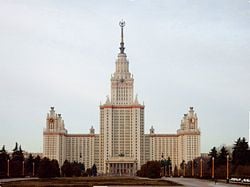
The word university means "institution of higher learning" or "body of persons constituting a university." The word comes from the Latin universitatum, meaning corporation or society.[1]
University is one type of tertiary education. Other forms include vocational schools and community colleges. Vocational schools are more narrow in their focus and often have some immediate professional goal in mind such as a training for a career as a paralegal or auto-mechanic. Community colleges offer continuing adult education for those interested in taking classes for personal enjoyment or interest. They also serve as preparatory schools for four year university undergraduate programs or as alternatives to those who cannot afford to enroll in a traditional four year program. In the United States, university is used to refer to schools offering graduate education while colleges offer undergraduate education.
History
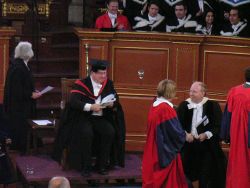
The first universities were not actually degree-granting institutions. The original Latin word universitas, first used in time of renewed interest in Classical Greek and Roman tradition, tried to reflect this feature of the Academy of Plato. The choice for the oldest institution of higher learning is usually among Nalanda, Constantinople, Al Karaouine or Al-Azhar. Nalanda University, founded in Bihar, India around the fifth century B.C.E. conferred academic degree titles to its graduates, while also offering post-graduate courses. Another Indian university whose ruins were only recently excavated was Ratnagiri University in Orissa. Chinese institutions of higher learning were the semi-legendary Shang Hsiang, and later Taixue and Guozijian serve as the highest level of educational establishment while academies became very popular as non-governmental establishments teaching Confucianism and Chinese literature among other things. Also the acdemy of Gundishapour is one of the oldest universities in the world, made around the fourth century C.E. in Iran.
Al-Azhar University, founded in Cairo, Egypt in the tenth century, offered a variety of post-graduate degrees, and is often regarded as the first full-fledged university. The University of Constantinople, founded in 849, by the regent Bardas of emperor Michael III, is generally considered the first institution of higher learning with the characteristics we associate today with a university (research and teaching, auto-administration, academic independence, et cetera). The Guinness Book of World Records recognizes the University of Al Karaouine in Fez, Morocco as the oldest university in the world with its founding in 859.
Byzantine university
Byzantine university refers to higher education during the era of the Byzantine empire.
The medieval Greek world had no autonomous and continuing institutions of higher learning comparable to the universities of the later Middle Ages in Western Europe, but higher education was provided by private teachers, professional groups and state appointed teachers.
In the early period Rome, Athens, and Alexandria were the main centers of learning, but were overtaken in the fifth century by the Queen of cities, Constantinople. After the closing of the Academy in Athens in 529 due to its pagan teachings, and the conquest of Alexandria and Beirut by the Arabs in the mid seventh century, the focus of all higher learning moved to Constantinople.
After the foundation of Constantinople in 330 teachers were drawn to the new city and various steps were taken for official state support and supervision, however nothing lastingly formal in the way of state funded education emerged. However in 425 Theodosius II established a clear distinction between teachers who were private, and those who were public and paid from imperial funds. These official teachers enjoyed privilege and prestige. There were a total of 31 teachers: ten each for Greek and Latin grammar; five for Greek rhetoric; three for Latin rhetoric; two for law; one for philosophy. This system lasted with various degrees of official support until the seventh century.
In the seventh and eighth centuries Byzantine life went through a difficult period (sometimes called the Byzantine Dark Age). Continued Arab pressure from the south and the Slavs, Avars and Bulgars to the north led to dramatic economic decline and transformation of Byzantine life. However during this period higher education continued to receive some official funding, the details of which are not well known to scholars, but it is assumed the quality of the education was probably low.
With improving stability in the ninth century came measures to improve the quality of higher education. In 863 chairs of grammar, rhetoric and philosophy (includes mathematics, astronomy, and music) were founded and given a permanent location in the imperial palace. These chairs continued to receive official state support for the next century-and-a-half, after which the leading role in the provision of higher education was taken up the Church. During the twelfth century the Patriarchal School was the leading center of education which included men of letters such as Theodore Prodromos and Eustathius of Thessalonica.
The capture of Constantinople in 1204 by Crusaders during the Fourth Crusade ended all support for higher education, although the government in exile in Nicaea gave some support to individual private teachers. After the restoration in 1261 attempts were made to restore the old system, but it never fully recovered and most teaching fell to private teachers and professions. Some of these private teachers include the diplomat and monk Maximos Planudes (1260-1310), the historian Nikephoros Gregoras (1291-1360), and the man of letters Manuel Chrysoloras, who taught in Florence and influence the early Italian humanists on Greek studies. In the fifteenth century many more teachers from Constantinople would follow in Chrysoloras' footsteps.
Medieval European universities
The first European medieval institutions generally considered to be universities were established in Italy, France, and England in the late eleventh and the twelfth centuries for the study of arts, law, medicine, and theology. These universities evolved from much older schools and monasteries, and it is difficult to define the date at which they became true universities, although the lists of studia generalia for higher education in Europe held by the Vatican are a useful guide. A different case is the university of Constantinople, which was founded in the ninth century as a secular institute of higher learning, to support the state administration.
With the increasing professionalization of society during the twelfth and thirteenth centuries, a similar demand grew for professional clergy. Before the twelfth century, the intellectual life of Europe had been relegated to monasteries, which were mostly concerned with the study of the liturgy and prayer; very few monasteries could boast true intellectuals. Following the Gregorian Reform's emphasis on canon law and the study of the sacraments, bishops formed cathedral schools to train the clergy in Canon law, but also in the more secular aspects of church administration, including logic and disputation for use in preaching and theological discussion, and accounting to more effectively control finances.
Learning became essential to advancing in the ecclesiastical hierarchy, and teachers also gained prestige. However, demand quickly outstripped the capacity of cathedral schools, each of which was essentially run by one teacher. In addition, tensions rose between the students of cathedral schools and burghers in smaller towns. So, cathedral schools migrated to large cities, like Paris and Bologna.
The predecessor of the modern university found its roots in Paris, especially under the guidance of Peter Abelard, who wrote Sic et Non ("Yes and No"), which collected texts for university study. Dissatisfied with tensions between burghers and students and the censorship of leading intellectuals by the Church, Abelard and others formed the Universitas, modeled on the medieval guild, a large-scale, self-regulating, permanent institution of higher education.
By the thirteenth century, almost half of the highest offices in the Church were occupied by degreed masters (abbots, archbishops, cardinals), and over one-third of the second-highest offices were occupied by masters. In addition, some of the greatest theologians of the High Middle Ages, Thomas Aquinas and Robert Grosseteste, were products of the medieval university.
The development of the medieval university coincided with the widespread reintroduction of Aristotle from Byzantine and Arab scholars and the decline in popularity of Platonism and Neoplatonism in favor of Aristotelian thought.
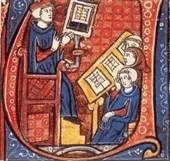
Initially medieval universities did not have a campus. Classes were taught wherever space was available such as churches and homes, a university was not a physical space but a collection of individuals banded together as a universitas (the corporation). Soon, however, some universities (such as Cambridge) began to buy or rent rooms specifically for the purposes of teaching.
Universities were generally structured along three types, depending on who paid the teachers. The first type was in Bologna, where students hired and paid for the teachers. The second type was in Paris, where teachers were paid by the church. Oxford and Cambridge were predominantly supported by the crown and the state, a fact which helped them survive the Dissolution of the Monasteries in 1538 and the subsequent removal of all the principal Catholic institutions in England. These structural differences created other characteristics. At the Bologna university the students ran everything—a fact that often put teachers under great pressure and disadvantage. In Paris, teachers ran the school; thus Paris became the premiere spot for teachers from all over Europe. Also, in Paris the main subject matter was theology, so control of the qualifications awarded was in the hands of an external authority—the Chancellor of the diocese. In Bologna, where students chose more secular studies, the main subject was law.
University studies took six years for a Bachelor's degree and up to 12 additional years for a master's degree and doctorate. The first six years were organized by the faculty of arts, where the seven liberal arts were taught: arithmetic, geometry, astronomy, music theory, grammar, logic, and rhetoric. The primary emphasis was on logic.
Once a Bachelor of Arts degree had been conferred, the student could leave the university or pursue further studies, in one of the three other faculties—law, medicine, or theology—in which to pursue the master's degree and doctorate degree. Theology was the most prestigious area of study, and the most difficult.
Courses were offered according to books, not by subject or theme. For example a course might be on a book by Aristotle, or a book from the Bible. Courses were not elective: the course offerings were set, and everyone had to take the same courses. There were, however, occasional choices as to which teacher to use.
Students entered the University at 14 to 15 years of age. Classes usually started at 5:00 a.m. or 6:00 a.m.. Students were afforded the legal protection of the clergy. In this way no one was allowed to physically harm them; they could only be tried for crimes in a church court, and were thus immune from any corporal punishment. This gave students free rein in urban environments to break secular laws with impunity, a fact which produced many abuses: theft, rape, and murder were not uncommon among students who did not face serious consequences. This led to uneasy tensions with secular authorities. Students would sometimes "strike" by leaving a city and not returning for years. This happened at the University of Paris strike of 1229 after a riot (started by the students) left a number of students dead; the University went on strike and they did not return for two years. As the students had the legal status of clerics which, according to the Canon Law, could not be held by women, women were not admitted into universities.
A popular textbook for university study was called the Sentences (Quattuor libri sententiarum) of Peter Lombard; theology students and masters were required to write extensive commentaries on this text as part of their curriculum. Much of medieval thought in philosophy and theology can be found in scholastic textual commentary because scholasticism was such a popular method of teaching.
Most universities of international excellence in Europe were registered by the Holy Roman Empire as a Studium Generale. Members of these institutions were encouraged to disseminate their knowledge across Europe, often giving lecture courses at a different Studium Generale.
Medieval Asian universities
Outside of Europe, there were many notable institutions of learning throughout history. In China, there was the famous Hanlin Academy, established during the Tang Dynasty (618-907 C.E.), and was once headed by the Chancellor Shen Kuo (1031-1095), a famous Chinese scientist, inventor, mathematician, and statesman.
Medieval universities did not exist in Asia in the strict sense of the phrase. However, there were important centers of learning that can be compared to the universities of Europe. It must be noted that unlike the European universities, non-western institutions of higher learning were never known to issue degrees to their graduates and therefore do not meet what many hold to be the technical definition of university. This does not, however, bar their importance to the history of non-western cultures.
One of the most important Asian centers of learning was Nalanda, which had been established by the fifth century B.C.E., in Bihar, India. The second century Buddhist philosopher Nagarjuna was based there.
Nanjing University was founded in 258 in China. There were several other universities, called Guozijian, in ancient China.
In Persia, one notable institution was the Academy of Gundishapur.
In the Near East, such as the Islamic Al-Azhar University in Cairo, founded in 988.
In Vietnam, the Quoc Tu Giam (國子監, literally "National University"), functioned for more than 700 years, from 1076 to 1779.
Emergence of modern universities
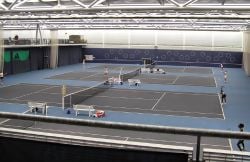
The end of the medieval period marked the beginning of the transformation of universities that would eventually result in the modern research university. Many external influences, such as eras of humanism, Enlightenment, Reformation, and revolution, shaped research universities during their development, and the discovery of the New World in 1492 added human rights and international law to the university curriculum.
By the eighteenth century, universities published their own research journals, and by the nineteenth century, the German and the French university models had arisen. The German, or Humboldtian model, was conceived by Wilhelm von Humboldt and based on Friedrich Schleiermacher’s liberal ideas pertaining to the importance of freedom, seminars, and laboratories in universities. The French university model involved strict discipline and control over every aspect of the university.
Universities concentrated on science in the nineteenth and twentieth centuries, and they started to become accessible to the masses after 1914. Until the nineteenth century, religion played a significant role in university curriculum; however, the role of religion in research universities decreased in the nineteenth century, and by the end of the nineteenth century, the German university model had spread around the world. The British also established universities worldwide, and higher education became available to the masses not only in Europe. In a general sense, the basic structure and aims of universities have remained constant over the years.
Nazi universities
Universities changed drastically in Nazi Germany. Books from university libraries, written by anti-Nazi or Jewish authors, were burned in places (in Berlin for example) in 1933, and the curricula were subsequently modified. Jewish professors and students were expelled according to the racial policy of Nazi Germany. University of Poznań was closed by the Nazi Occupation in 1939, its faculty replaced with German substitutes. University of Strasbourg was transferred to Clermont-Ferrand and Reichsuniversität Straßburg existed 1941–1944. Nazi-run universities ended with the fall of Nazi Germany in 1945.
Soviet universities
Soviet type universities existed in the Soviet Union and in other countries of the Eastern Bloc. Medical, technical, economical, technological and arts faculties were frequently separated from universities. Soviet ideology was taught divided into three disciplines: Scientific Communism, Marxism-Leninism, and Communist Political Economy) and was introduced as part of many courses, such as teaching Karl Marx' or Vladimir Lenin's views on energy or history. Sciences were generally tolerated, but humanities curbed. In 1922, the Bolshevik government expelled some 160 prominent intellectuals on the Philosophers' ship, later some professors and students were killed or worked in Gulag camps. Communist economy was preferred, liberal ideas criticized or ignored. Genetics was reduced to Lysenkoism from the middle of the 1930s to the middle of the 1960s. Communist parties controlled or influenced universities. The leading university was the Moscow State University. After Joseph Stalin's death, universities in some Communist countries obtained more freedom. The Patrice Lumumba Peoples' Friendship University provided higher education as well as a KGB training ground for young communists from developing countries. The system failed during the years 1989-1991. In some countries a number of communists and political police informers were expelled from universities, political universities resolved or reorganized.
Organization
Although each institution is differently organized, nearly all modern universities have a board of trustees, a president, chancellor or rector, at least one vice president, vice-chancellor or vice-rector, and deans of various divisions. Universities are generally divided into a number of academic departments, schools or faculties. Public university systems are ruled over by government-run higher education boards. They review financial requests and budget proposals and then allocate funds for each university in the system. They also approve new programs of instruction and cancel or make changes in existing programs. In addition, they plan for the further coordinated growth and development of the various institutions of higher education in the state or country. However, many public universities in the world have a considerable degree of financial, research and pedagogical autonomy. Private universities are privately funded having generally a broader independence from state policies.
Despite the variable policies, or cultural and economic standards available in different geographical locations create a tremendous disparity between universities around the world and even inside a country, the universities are usually among the foremost research and advanced training providers in every society. Most universities not only offer courses in subjects ranging from the natural sciences, engineering, architecture or medicine, to sports sciences, social sciences, law or humanities, they also offer many amenities to their student population including a variety of places to eat, banks, bookshops, print shops, job centers, and bars. In addition, universities have a range of facilities like libraries, sports centers, students' unions, computer labs, and research laboratories. In a number of countries, major classic universities usually have their own botanical gardens, astronomical observatories, business incubators, and university hospitals.
Criticism
In his study of the American university since World War II, The Knowledge Factory, Stanley Aronowitz argued that the American university has been besieged by growing unemployment issues, the pressures of big business on the land grant university, as well as the political passivity and "ivory tower" naivete of American academics. A part of these pressures results in debates over academic freedom in which professors, students, and administrators are coerced into working on or prevented from working on certain topics that may be controversial.
In a somewhat more theoretical vein, the late Bill Readings contended in his 1995 study The University in Ruins that the university around the world has been hopelessly commodified by globalization and the bureaucratic non-value of "excellence." His view is that the university will continue to linger on as an increasingly consumerist, ruined institution until or unless we are able to conceive of advanced education in transnational ways that can move beyond both the national subject and the corporate enterprise.
In some countries, in some political systems, universities are controlled by political and/or religious authorities, who forbid certain fields and/or impose certain other fields. Sometimes national or racial limitations exist—for students, staff, and research.
Notes
- ↑ University Online Etymology Dictionary. Retrieved March 27, 2020.
ReferencesISBN links support NWE through referral fees
- Aronowitz, Stanley. The Knowledge Factory, Boston, MA: Beacon, 2000. ISBN 0807031224
- Barrow, Clyde W. Universities and the Capitalist State: Corporate Liberalism and the Reconstruction of American Higher Education, 1894–1928. University of Wisconsin Press, 1990. ISBN 0299124045
- Browning, Robert. "The patriarchal school at Constantinople in the twelfth century," Byzantion Volume 32 (1962):167-202
- Browning, Robert. "Universities, Byzantine" in Dictionary of the Middle Ages. (12) (1989): 300.
- Cobban, Alan B. English University Life in the Middle Ages. Columbus, OH: Ohio State University Press, 1999. ISBN 0814208266
- Diamond, Sigmund. Compromised Campus: The Collaboration of Universities with the Intelligence Community, 1945–1955. Oxford University Press, 1992. ISBN 0195053826
- Ferruolo, Stephen. The Origins of the University: The Schools of Paris and their Critics, 1100-1215. Stanford, CA: Stanford University Press, 1998. ISBN 0804712662
- Haskins, Charles Homer. The Rise of Universities. Ithaca, New York: Cornell University Press, 1972. ISBN 0879683791
- Rait, Robert S. Life in the Medieval University Cambridge: Cambridge University Press, 1931. ISBN 0527736503
- Rashdall, Hastings, rev. by F. M. Powicke, and A. B. Emden. The Universities of Europe in the Middle Ages. 3 vols. Oxford: Clarendon Press, 1987. ISBN 0198214316
- Readings, Bill. The University in Ruins. Harvard University Press, 1996. ISBN 0674929535
- Ruegg, Walter (ed.). A History of the University in Europe. Cambridge University Press, (3 vols), 2004. ISBN 0521361079
- Seybolt, Robert Francis, (trans.). The Manuale Scholarium: An Original Account of Life in the Mediaeval University. Cambridge: Harvard University Press, 1921.
- Thorndike, Lynn, (trans. and ed.). University Records and Life in the Middle Ages, New York, NY: Columbia University Press, 1975. ISBN 039309216X
- Wilson, N. G. Scholars of Byzantium. London:Duckworth, 1983. ISBN 0715617052
External links
All links retrieved May 3, 2023.
- From Manuscript to Print: Evolution of the Mediaeval Book.
- Life of the Students at Paris.
- Cambridge, A Brief History: The Mediaeval University.
- Mediaeval Science, the Church, and Universities
Credits
New World Encyclopedia writers and editors rewrote and completed the Wikipedia article in accordance with New World Encyclopedia standards. This article abides by terms of the Creative Commons CC-by-sa 3.0 License (CC-by-sa), which may be used and disseminated with proper attribution. Credit is due under the terms of this license that can reference both the New World Encyclopedia contributors and the selfless volunteer contributors of the Wikimedia Foundation. To cite this article click here for a list of acceptable citing formats.The history of earlier contributions by wikipedians is accessible to researchers here:
- University history
- Medieval_university history
- Medieval_university_(Asia) history
- Byzantine_university history
The history of this article since it was imported to New World Encyclopedia:
Note: Some restrictions may apply to use of individual images which are separately licensed.

